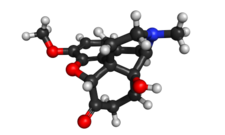옥시코돈

| |

| |
| 체계적 명칭 (IUPAC 명명법) | |
|---|---|
| (5R,9R,13S,14S)-4,5α-Epoxy-14-hydroxy-3-methoxy-17-methylmorphinan-6-one | |
| 식별 정보 | |
| CAS 등록번호 | 76-42-6 |
| ATC 코드 | N02AA05 N02AA55 (in combinations) |
| PubChem | 5284603 |
| 드러그뱅크 | DB00497 |
| ChemSpider | 4447649 |
| 화학적 성질 | |
| 화학식 | C18H21NO4 |
| 분자량 | 315.364 g/mol |
| 유의어 | Eukodal, eucodal; dihydrohydroxycodeinone, 7,8-dihydro-14-hydroxycodeinone, 6-deoxy-7,8-dihydro-14-hydroxy-3-O-methyl-6-oxomorphine[1] |
| 물리적 성질 | |
| 녹는점 | 219 °C (426 °F) |
| 물에 대한 용해도 | HCl: 166 mg/mL (20 °C) |
| 약동학 정보 | |
| 생체적합성 | By mouth: 60–87%[2][3] |
| 단백질 결합 | 45%[2] |
| 동등생물의약품 | ? |
| 약물 대사 | 간: mainly en:CYP3A, and, to a much lesser extent, en:CYP2D6 (~5%);[2] 95% metabolized (i.e., 5% excreted unchanged)[4] |
| 생물학적 반감기 | By mouth (IR): 2–3 hrs (same t1/2 for all ROAs)[4][3] By mouth (CR): 4.5 hrs[5] |
| 배출 | 오줌 (83%)[2] |
| 처방 주의사항 | |
| 임부투여안전성 | C(오스트레일리아) B(미국) |
| 법적 상태 |
|
| 중독 경향 | High |
| 투여 방법 | By mouth, sublingual, intramuscular, intravenous, intranasal, subcutaneous, transdermal, rectal, epidural[6] |
옥시코돈(oxycodone, 상표명: 옥시콘틴(OxyContin) 등)은 온화한 정도에서부터 심각한 정도에 이르는 통증을 치료하기 위해 사용되는 오피오이드 약물이다.[7] 구강을 통해서 투여되는 것이 보통이며, 즉각 방출(immediate release, IR) 또는 통제된 방출 형태로도 판매된다.[7] 통증 완화는 보통 15분 내에 시작되며 즉각 방출형을 사용하면 최대 6시간까지 지속된다.[7] 영국에서는 주사 형태로 판매된다.[8] 아세트아미노펜이나 아스피린과 더불어 복합약 또한 구매할 수 있다.[7]
일반적인 부작용으로는 변비, 구역질, 졸림, 어지럼증, 가려움, 구강건조증, 땀이 포함된다.[7] 심각한 부작용으로는 탐닉, 호흡 억제(호흡 노력의 저하), 저혈압이 포함될 수 있다.[7] 코데인에 알레르기 반응이 있는 사람은 옥시코돈에도 알레르기 반응을 보일 수 있다.[7] 임신 초기에 옥시코돈을 복용하는 것은 상대적으로 안전한 것으로 간주된다.[7] 급속도로 중단할 경우 오피오이드 금단이 발생할 수 있다.[7] 옥시코돈은 μ-오피오이드 수용체를 활성화시킴으로써 동작한다.[9] 구강으로 섭취 시 같은 양의 모르핀 대비 대략 1.5배의 효력이 있다.[10]
옥시코돈은 1916년 독일에서 테바인에서 추출하여 처음 개발되었다.[11] 제네릭 의약품으로 구매할 수 있다.[7] 미국의 1도스 당 도매가는 2018년 기준으로 0.30 USD 미만이다.[12] 2016년, 1400만 건 이상의 처방과 더불어 미국에서 54번째로 많이 처방된 약물이었다.[13] 옥시코돈은 일반적인 남용 약물이 되고 있다.[14]
각주[편집]
- ↑ O'Neil, Maryadele J., 편집. (2006). 《The Merck index》 14판. Whitehouse Station, NJ: Merck & Co. ISBN 978-0-911910-00-1.
- ↑ 가 나 다 라 “Roxicodone, OxyContin (oxycodone) dosing, indications, interactions, adverse effects, and more”. 《Medscape Reference》. WebMD. 2014년 4월 8일에 확인함.
- ↑ 가 나 Jennifer A. Elliott; Howard S. Smith (2016년 4월 19일). 《Handbook of Acute Pain Management》. CRC Press. 82–쪽. ISBN 978-1-4665-9635-1.
- ↑ 가 나 Howard Smith; Steven Passik (2008년 4월 25일). 《Pain and Chemical Dependency》. Oxford University Press USA. 195–쪽. ISBN 978-0-19-530055-0.
- ↑ Richard A. McPherson; Matthew R. Pincus (2016년 3월 31일). 《Henry's Clinical Diagnosis and Management by Laboratory Methods》. Elsevier Health Sciences. 336–쪽. ISBN 978-0-323-41315-2.
- ↑ Kalso E (2005). “Oxycodone”. 《Journal of Pain and Symptom Management》 29 (5S): S47–S56. doi:10.1016/j.jpainsymman.2005.01.010. PMID 15907646.
- ↑ 가 나 다 라 마 바 사 아 자 차 “Oxycodone Monograph for Professionals”. 《Drugs.com》 (영어). AHFS. 2018년 12월 28일에 확인함.
- ↑ 《British national formulary : BNF 74》 74판. British Medical Association. 2017. 442쪽. ISBN 978-0857112989.
- ↑ Nicholas J Talley; Brad Frankum; David Currow (2015년 2월 10일). 《Essentials of Internal Medicine 3e》. Elsevier Health Sciences. 491–쪽. ISBN 978-0-7295-8081-6.
- ↑ “Stanford School of Medicine, Palliative Care, Opioid Conversion / Equivalency Table”. 2013년 4월 20일. 2020년 9월 9일에 원본 문서에서 보존된 문서. 2019년 3월 1일에 확인함.
- ↑ Sneader, W. (2005). 《Drug discovery: a history》. Hoboken, NJ: Wiley. 119쪽. ISBN 978-0-471-89980-8.
- ↑ “NADAC as of 2018-12-19”. 《Centers for Medicare and Medicaid Services》 (영어). 2018년 12월 19일에 원본 문서에서 보존된 문서. 2018년 12월 22일에 확인함.
- ↑ “The Top 300 of 2019”. 《clincalc.com》. 2018년 12월 22일에 확인함.
- ↑ Pergolizzi JV, Jr; Taylor R, Jr; LeQuang, JA; Raffa, RB (2018). “Managing severe pain and abuse potential: the potential impact of a new abuse-deterrent formulation oxycodone/naltrexone extended-release product.”. 《Journal of Pain Research》 11: 301–311. doi:10.2147/JPR.S127602. PMID 29445297.
- [참고]약학정보원,옥시콘틴
추가 문헌[편집]
- Coluzzi, F.; Mattia, C. (July–August 2005). “Oxycodone. Pharmacological profile and clinical data in chronic pain management” (PDF). 《Minerva Anestesiol》 71 (7–8): 451–60. PMID 16012419. 2006년 3월 9일에 원본 문서 (PDF)에서 보존된 문서.
